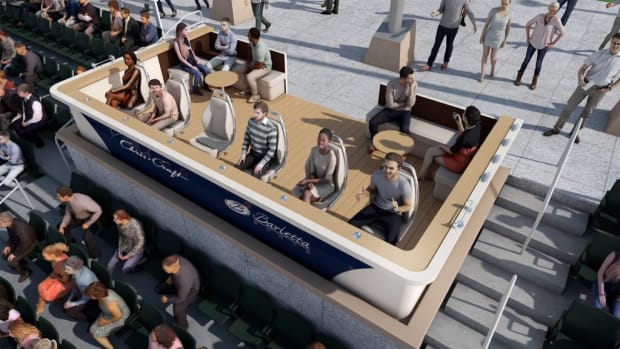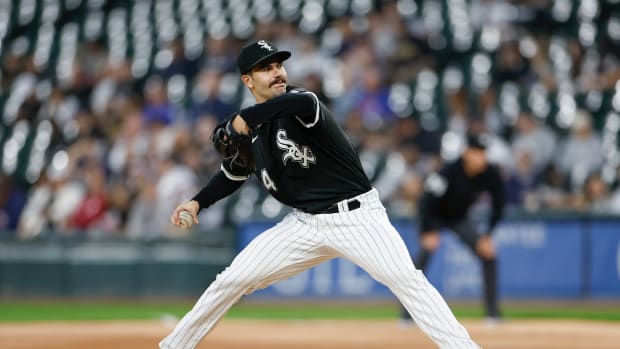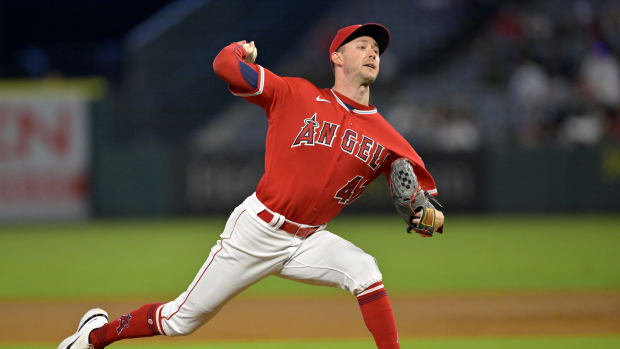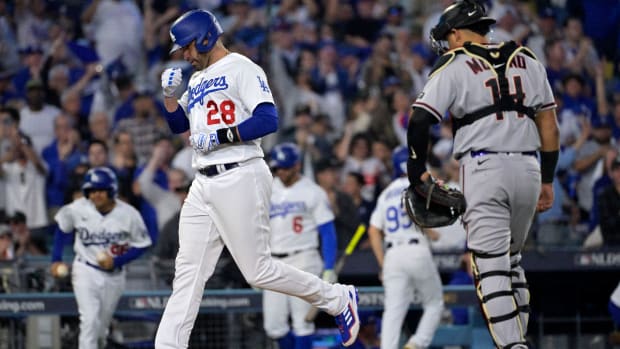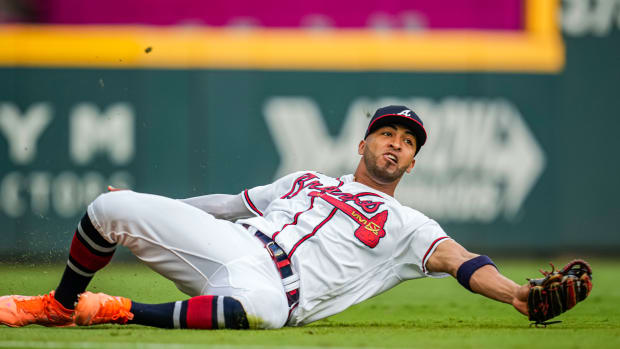NLDS Preview: Brewers vs. Phillies
It was also the end of the line for Brewers manager Ned Yost. The day after the sweep, GM Doug Melvin fired him in a nearly unprecedented move. Bench coach Dale Sveum inherited the reins of a shell-shocked club which proceeded to lose four out of its next five games to fall 2 1/2 back in the wild card. The Brewers appeared poised to end another season with a cry of "Wait 'Til Next Year," one all the more agonizing given the likely departures of long-time ace Ben Sheets and mid-season acquisition CC Sabathia, the latter of whom had pitched well enough since coming over in early July to generate talk of a Cy Young Award.
On the strength of some dramatic home runs from a homegrown nucleus of Ryan Braun, Prince Fielder and Rickie Weeks, and a pair of victories on three days' rest by Sabathia, the Brewers went 6-1 over the final week. The run culminated with a dramatic win on the final day of the regular season, bringing them their first postseason berth since the "Harvey's Wallbangers" club of 1982.
At their most fundamental level, both of these offenses share some common traits. Both put the ball in play less than the average NL team and have low batting averages when they do. Both make up for it with serious doses of thunder from numerous spots in the order, and ranking among the majors' top five teams in terms of the percentage of runs generated by homers. But far from being units of slow-footed sluggers waiting around for the long ball, both augment their attacks with surprising amounts of speed via high-percentage stolen-base threats. The gap in their raw scoring levels (4.9 runs per game for the Phillies, second in the league, and 4.6 runs per game for the Brewers, seventh) is slightly distorted by their ballparks; Citizens Bank Ballpark favors hitters while Miller Park tilts toward pitchers.
The Phillies led the league in homers (214), with seven players reaching double digits and three more finishing with nine. Ryan Howard paced the circuit with 48, thanks to a monster September (.352/.422/.852 with 11 homers) that made up for a frigid April (.172/.297/.343) and may net him a second MVP award. That said, he's not anywhere close to this lineup's most valuable player, let alone the league's; his 5.4 WARP3 ranks behind Chase Utley (10.6), Shane Victorino (7.6), Jimmy Rollins (7.4), Jayson Werth (7.1) and Pat Burrell (6.0). Utley tied with Burrell for second on the team with 33 homers, and he's the real superstar of the offense, getting on base far more often than Howard. But he suffered a considerable second-half drought while playing through a minor hip injury, connecting for just eight homers and slugging .465 after the All-Star break, compared to 25 homers and .582 beforehand. Burrell tailed off even more drastically after the break, from .275/.404/.575 with 23 homers to .215/.313/.413 with 10. Rollins, the 2007 NL MVN (Most Valuable Narrative) winner, fell off considerably in the power department from last year (30 homers and .531 SLG), but the sprained ankle that cost him a month early in the season appears not to have affected his speed; he went 47 for 50 in stolen bases.
The supporting cast beyond those four is reasonably strong. Werth spent the first four and a half months of the season platooning with Geoff Jenkins but claimed the job as his own once the latter went down with a hip flexor strain in mid-August. He set career highs in playing time, home runs (24) and steals (20, in 21 attempts). Victorino provides a healthy dose of offense for a center fielder, with a game centered more around speed (36 steals) than power (14 homers). Carlos Ruiz suffered a down year with the bat but was much closer to adequate as a hitter in the second half.
The main moving parts in the Phillies lineup involve third base and Utley's spot in the order. Concerning the former, Greg Dobbs is the better hitter of the two hot cornermen, but far inferior with the glove to platoon-mate Pedro Feliz. Manager Charlie Manuel tends to factor his own starting pitcher into the equation of who plays, showing a strong tendency to favor the better fielder behind lefties Cole Hamels and Jamie Moyer -- Dobbs drew just three starts behind those two -- and the better hitter behind righties Brett Myers and JoeBlanton. Utley spent the bulk of the year batting third but moved up to second more often for the final five weeks. Splitting the two slugging lefties makes it more risky for an opposing manager to deploy a lefty specialist, but on the other hand it's really only Howard (.224/.294/.451) who suffers in the presence of southpaws.
As for the Brewers, they were third in the league in home runs (198), with eight players reaching double digits and five reaching 20. Ryan Braun, who led the team with 37, cracked two of the most memorable shots in franchise history over the season's final four days, offering hope that the intracostal strain that hampered him for most of September is improving. He hit one homer and slugged .292 from Aug. 30 to Sept. 24, a span during which the team's scoring dropped to 4.0 runs per game on .396 slugging. Prince Fielder hit 34 homers but was subject to barren stretches throughout the year that made him a considerably less potent threat than in 2007. On the other hand, with a .316/.398/.600 September, he's swinging the bat better than at any time all year.
The deployment of players surrounding that dynamic duo changed with the managerial switch. Sveum's first action was to shake up the lineup by installing Cameron in the leadoff spot -- a counter-intuitive move given his contact woes -- and to bat Ray Durham second, while moving J.J. Hardy to the middle of the order and shifting Rickie Weeks into the short half of a platoon role. With Hamels going in Game 1, Weeks (.391 OBP versus lefties) gets the call, albeit in a spot further down the order. Against Myers in Game 2 the switch-hitting Durham will likely return to the two slot. Such matchup talk brings up a point that may be the key to the series: The Brewer lineup tilts further to the right than Sarah Palin, leaving them with a considerable platoon split: .246/.317/.421 versus righties, compared to .269/.348/.458 versus lefties. Given that, drawing Hamels and Moyer for two of the first three games might count as a bit of a break if Hamels himself didn't in fact enjoy a reverse platoon split: .215/.261/.356 against righties, .262/.308/.471 against lefties this year, and an overall gap of about 71 points of OPS over his three-year career.
Further down the order the Brewers have serious OBP issues; this segment of the lineup is where rallies go to die. Hardy has responded well to moving down the lineup, but Hart has been in a dreadful slump (.173/.192/.245 in September) amid a year in which he couldn't match his stellar 2007 contributions. Hall provides a potent bat against lefties (.306/.371/.522) but is helpless against righties (.174/.242/.316), so Sveum will likely start Craig Counsell against Myers. Jason Kendall, 34, appears to be flagging due to his insane workload (149 games); he hit just .202/.295/.298 in September.
The Brewers are a slightly above-average team when it comes to stealing bases, succeeding at a 74 percent clip, with the four players in double digits -- Hart with 23, Weeks with 19, Cameron with 17 and Braun with 14 -- all a bit better than that. Even so, that can't touch the Phillies, who succeeded at an 84 percent clip.
Both of these teams have reasonably good benches, but they may be of differing utility in this series. The aforementioned tendency for Dobbs to play behind the two righties will probably be trumped by the fact that the lefty Sabathia will be squaring off against Myers; Dobbs has just 10 PA against southpaws this year. Given his stellar performance as a pinch-hitter (.355/.388/.532 with an MLB-high 22 hits), he's in no danger of rusting, however. Stairs offers another game-changing threat in a pinch; he was 4 for 12 with two homers in September and boasts a career .281/.377/.513 line in 308 pinch-hit PA. In all the Phillies led the league with nine pinch homers and ranked second in pinch-hitter OPS on a .252/.309/.415 performance.
As for the rest, they're likely to be non-factors except for Chris Coste, who's more than ornamental relative to most backup catchers on post-season rosters. He started 22 of Myers' last 24 starts and figures to get the call in Game 2. Jenkins, the former Brewer, has been an afterthought of late, drawing just two starts and 13 plate appearances since his initial injury; at best he's the number-three lefty pinch-hitter here. So Taguchi has little value except as a defensive replacement and pinch-runner, and Werth's ascendance to the full-time starter job in right field basically limits Taguchi to being a caddy for Burrell. Even that's no guarantee, as Manuel experimented with Eric Bruntlett in that role in September.
Turning to the Brewers, Durham theoretically makes for a handy combination of peskiness and punch off the bench in games started by southpaws, but he's never found much success pinch-hitting, and went just 4 for 32 in that role this year. He and Counsell will likely start against Myers, and while the latter is laughably short of power, his patience at the plate proved critical down the stretch; he drew 16 walks in 20 September games while finding himself in the middle of some of the final week's crucial rallies. Tony Gwynn Jr. is on the roster because of the injury to Gabe Kapler, the team's top pinch-hitter; Little Tony will most likely be limited to pinch-running duty. Brad Nelson, the Brewers' top hitting prospect circa 2003, was a surprising addition to the roster given that he drew just eight plate appearances for the big club, but he got the nod over a healthy Joe Dillon and an unhealthy Russell Branyan. Like the two bypassed players, he can play all four corner positions passably enough. Mike Rivera is merely ornamental, and should even the most minor foreign dignitary pass away during this series, he'll likely be excused to attend the funeral on behalf of the Brewers.
As units the Phillies ranked seventh and the Brewers third in SNLVAR, but key people who helped generate those rankings are absent here, for better or worse. Hamels solidified his claim as a bona fide ace, shaking off a reputation for fragility -- this was his first injury-free season since his A-ball days in 2003 -- to finish second in the league in innings pitched. He also finished sixth in both ERA and strikeouts and sixth in the majors in SNLVAR. Given that he's never thrown on three days' rest before, he may not come back until Game 5, leaving the Phillies to giving Blanton a start.
Myers is an enigma. After spending most of last year as the team's closer he returned to the rotation and put up an unsightly 5.84 ERA in the first half of this year before accepting an option to the minors. He made four starts across three levels while ironing out his mechanics, and the returns were promising; he put up a 1.80 ERA over his next 11 starts, including a two-hit complete game against the Brewers on three days' rest in Yost's swan song. A pair of bombings to end the regular season tacked half a run onto his ERA and raised injury concerns, but the Phils feel that his woes are mechanical in nature and thus correctable.
The soft-tossing 45-year-old Moyer put up his best ERA in five years thanks to newfound stinginess with regard to the long ball; he surrendered just six homers in the second half and only two on the road, which could disappoint souvenir-hunters in Milwaukee. Blanton hasn't pitched all that well despite a superficially tidy 4-0 record since being acquired from Oakland, managing just four quality starts out of 13 as a Phil. He's got his place as staff filler, but his mediocrity may tempt Manuel to bring back Hamels on short rest if they're facing elimination in Game 4.
The Brewers arrive at this juncture with no shortage of question marks regarding their rotation: Will Ben Sheets pitch? Can Yovani Gallardo go deep into a game? Can Sabathia withstand another start on three days' rest? Won't somebody please put Jeff Suppan out of our misery? How can the Brewers survive given that no starter besides Sabathia has lasted longer than five innings since Sveum took over?
Sheets is off the roster, having fallen prey to elbow woes that put a damper on his finest season since 2004. MRIs taken on Monday revealed that he has a torn flexor mass, meaning that he has almost certainly thrown his last pitch of the year. That might be a fatal blow to the Brewers' chances were it not for the return of Gallardo, who has made exactly one start since returning from the torn ACL he suffered on May 1. The 22-year-old threw 67 pitches over four innings in his return, striking out seven and maintaining a velocity in the low 90s. If everything is in order he'll probably make 80-90 pitches before handing off to the bullpen. The Philly lineup is the more patient of the two, and they could turn this into an advantage by working the count and attempting to wait Gallardo out.
That leaves Sabathia to start Game 2. The savior of the Brewers' season set career highs in starts, innings, strikeouts (251, second in the majors), complete games (10, tops in the majors), and shutouts (five, ditto), and it's anyone's guess as to whether he's got anything in the tank coming off his intense, emotional, 122-pitch effort in the finale. Memories of his poor performances in last year's playoffs following a 241-inning regular-season tally only add to the concern, but on a positive note he has put up an 0.83 ERA (2.49 RA) during his run of short-rest starts, thanks to increased reliance on his changeup; he may have a few tricks up his sleeve yet. If the Brewers make it to Game 5 he'll start on four days' rest.
Sveum hasn't committed to a starter beyond Game 2. Dave Bush, who put up a 3.27 ERA over the last two months, is a reasonable bet for Game 3. Suppan, who parlayed the 2006 NLCS MVP award into a four-year, $42 million deal the following winter, is a less secure bet for Game 4 given his 8.44 ERA and 4.3 IP/GS in September. Assuming he isn't overextended by long-relief work by then, Seth McClung could get the call; he compiled a 4.24 ERA and 1.5 SNLVAR in 12 starts before being crowded out of the rotation, and put up a 1.10 ERA in September, primarily out of the bullpen. Manny Parra is a less likely option given the way he was torched by the Phillies on Sept. 13, but he's on the roster, too.
The Phillies' bullpen represents a significant advantage over the Brewers in this series. They led the NL in WXRL by almost three and a half wins on the strength of Brad Lidge's MLB-best numbers. Lidge converted all 41 of his save opportunities, and prior to yielding a run on Sept. 27 had been scored upon in just two of his previous 28 outings over a two-month span. If the Phillies can take a lead into the ninth inning, game over.
Ahead of him Ryan Madson serves primarily as the eighth-inning righty, Chad Durbin as the seventh-inning righty, with J.C. Romero getting the high-leverage situational-lefty opportunities that fall between them. That the Brewers really have only one lefty threat could help Manuel, because there will be no temptation to leave Romero in to face righty hitters stashed between lefties. Righties beat Romero to a .282/.444/.455 tune this year, while lefties hit a sickly .102/.193/.153 against him. Scott Eyre gives Manuel a second lefty specialist to go to in the middle innings, but he may not be needed if the Phils get reasonable length from their starters. Clay Condrey and James Happ are the lower-leverage guys, ready for an early-inning cleanup in Aisle 5.
The Brewers' bullpen ranked only three spots behind the Phillies in terms of WXRL, but the drop-off between the two clubs is steep, 6.5 wins. Over the winter Melvin took a huge risk by laying out $10 million for one year of Eric Gagne, who hadn't completed a healthy season since 2004, and the move backfired. He blew five out of 15 save opportunities over the first two months before going on the disabled list with rotator cuff tendonitis and a 6.98 ERA, not necessarily in that order. Into the breach stepped Salomon Torres, the former Pirates ironman. He converted 25 out of 29 opportunities as the primary closer coming into September, but was clobbered for an 8.53 ERA and more than two baserunners per inning over the final month. He remains a shaky proposition, and another high-profile failure might be enough to induce Sveum to go back to Gagne, who's been scored upon just once since Sept. 2 while working the seventh and eighth.
The rest of the unit doesn't inspire tremendous confidence either, though Guillermo Mota was scored upon in just two games over the final two months while putting up a 1.50 ERA, mostly in eighth-inning work. Brian Shouse has a huge split between lefties (.180/.196/.290) and righties (.301/.377/.452), the failure of which to abide served as the final straw regarding Yost. Michael Stetter is the second lefty who seemed to surface in lost causes; the Brewers were 10-20 in the games he pitched. Carlos Villanueva found a home pitching the sixth and seventh after being banished from the rotation early on. McClung is the long man, and on Sept. 26 he showed just how important such a job is to a battered rotation, as he worked the final four innings in relief of Suppan; he could wind up doing similar work if Gallardo falters. Parra, as the third lefty out of the pen, might be for an even more dire, break-glass-in-emergency situation -- a case where Sveum needs to escape an early-inning jam and then pinch-hit for the pitcher's spot.
Both of these teams can make a case as slightly above-average defensively. The Brewers finished second in the league in raw Defensive Efficiency, seventh in Park Adjusted Defensive Efficiency, and a tidy plus-20Fielding Runs Above Average. That they rate so highly is a testament to the work done by Melvin last winter to shore up a unit that was 28th out of 30 in PADE last year. Free agents Cameron and Kendall dramatically shored up weak spots, and the shifts of Braun from third base to left field and Hall from center field to third base worked out well, too. Kendall threw out a major league-leading 42.7 percent of attempted thefts and was 15 runs above average behind the plate according to FRAA. Fielder (-10 FRAA) and Hart (-5 FRAA) are the only regulars who rate below average by BP's metrics. Additionally it's worth noting that Hardy placed third among major league shortstops in Plus/Minus, available via Bill James Online, while Braun and Cameron both cracked the top 10 at their respective positions -- further testament to Melvin's makeover.
There's far less backstory to the Phillies' defense, which ranked fifth in the league in raw Defensive Efficiency and fourth in PADE at 0.59 percent above average. The Davenport numbers provide a slightly less sanguine view (-3 FRAA), showing Howard (-14) and Burrell (-11) as outright liabilities; hence the latter's frequent departures for a defensive replacement. Everywhere else the team rates as average or better, with Werth (+9, spread across all three outfield spots) rating the highest according to FRAA. On the Plus/Minus tip, Utley and Rollins top their respective positions (the former by nearly doubling the second-ranked Mark Ellis, +50 to +26), and Victorino places among the top 10 in center field. Behind the plate, neither Ruiz (23.5 percent caught) nor Coste (22.8 percent caught) are particularly effective at curtailing the running game, which may create an opportunity for the Brewers to exploit.
Sveum is mostly an unknown commodity; no manager has ever entered the postseason with less experience. He showed a willingness to shake things up upon taking over, particularly in the lineup, and by most accounts he's served as a stabilizing influence during a potentially traumatic time. He seems well aware that the makeup of his club precludes an over-reliance on small-ball tactics, but it will be interesting to see if he changes his mind if his offense again finds itself pressing. He's had his ups and downs navigating around a pitching staff that's full of holes, and the potential for land mines remains high, particularly given Gallardo's limitations and the recent shakiness of Torres.
For the second year in a row Manuel piloted a team that started slowly but wound up bringing home a division flag, making him just the third Phillies manager to take the team to the postseason in back-to-back years. He'll never be mistaken for Lou Piniella; he has succeeded with a minimum of drama and controversy. He'll never be mistaken for Tony La Russa with his funky lineups or in-game tactics, but he's shown a modicum of creativity in cobbling together platoons at third base and flexibility by letting Werth take over right field instead of forcing a platoon once the injury to Jenkins struck. He's in this position in part because of the performance of his bullpen, but that's more a function of Lidge having shored up the closer role and rediscovered his dominant form; few would have accused Manuel of having a deft touch with his relievers prior to this year.
Despite the state of Milwaukee's pitching staff, this is a more even series than it might appear to be at first glance. That the Brewers might face southpaw starters three times in a five-game series helps their cause just a hair due to two of those starts being taken by Hamels. The biggest difference between the two clubs appears to be at the front end of their bullpens, where the Phils enjoy a considerable advantage, and the feeling here is that unless the Brewers can find a way to get Sabathia a second turn on the hill for a Game 5, that bullpen edge will prove decisive. I'm predicting the Phillies in four, but if the Brewers can force a rubber game, my money's on the big man.






























